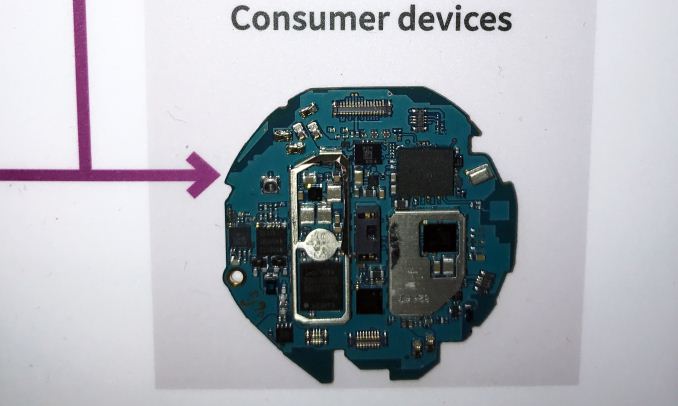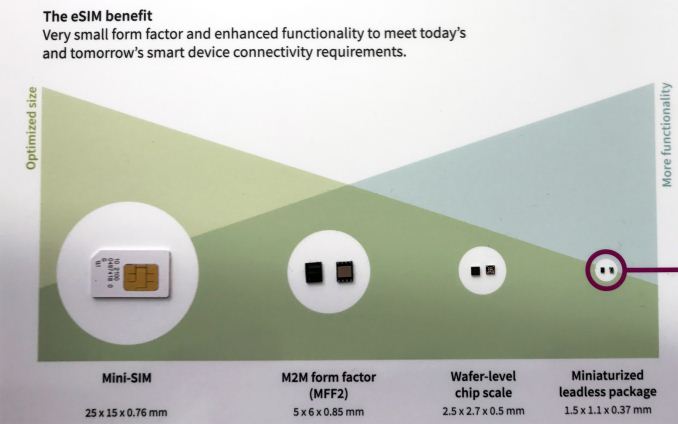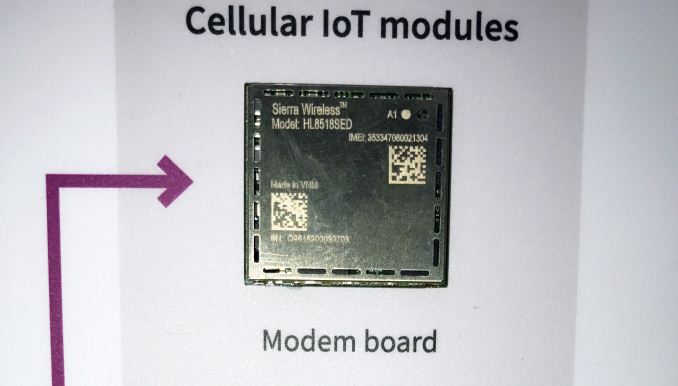Infineon Shows Off Future of eSIM Cards: <1.65 mm2 Made Using 40 nm
by Anton Shilov on March 11, 2017 5:00 PM EST- Posted in
- MWC_2017
- Mobile
- Trade Shows
- Smartwatch
- eSIM
- Infineon
- M2M
- SIM

Update 3/20: Infineon has contacted us and said that the eSIM IC is made using a 40 nm process technology.
At MWC this year, Infineon showcased a lineup of its current and embedded SIM products. The company demonstrates not only the industry-standard MFF2 eSIM chip, but also considerably smaller ICs designed for future miniature devices (many of which may not even exist yet as a category) as well as M2M (machine to machine) applications. It is noteworthy that to manufacture an eSIM the size of a match head, Infineon uses GlobalFoundries 14LPP a 40 nm process technology, taking advantage of leading-edge lithography to bring the size of a simple device down.
The first SIM cards were introduced in 1991 along with the world’s first GSM network operated by Radiolinja in Finland (now the company is called Elisa). Back then, mobile phones were so bulky that a card the size of a credit card (1FF) could fit in. Eventually, handsets got smaller, Mini-SIMs (2FF) replaced full-sized SIMs and then Micro-SIM (3FF) and Nano-SIM (4FF) cards took over. While mobile phones have evolved considerably in terms of feature-set in the last 25 years, the function of the SIM card remained the same: it stores an integrated circuit card identifier (ICCID), an international mobile subscriber identity (IMSI), a location area identity, an authentication key (Ki, this part actually requires a basic 16- or 32-bit compute unit) as well as a phone book and some SMS messages.
By today’s standards, the amount of data that each SIM card stores is so tiny that its physical dimensions are simply not justified. Even Nano-SIMs are too large for applications like a smartwatch, and this is when embedded SIMs come into play: their form-factor is considerably smaller, they can be used with various operators (which makes them more flexible in general) and some of such cards have an expanded feature set (e.g., hardware crypto-processors). Today, there is one internationally recognized form-factor for eSIMs, the MFF2, which is used inside devices like Samsung’s Gear series smartwatch with GSM/3G connectivity. If we actually take a look inside the Gear S2 smartwatch, we will notice that the eSIM is actually one of the largest components and its functionality is disproportional to its dimensions.
At MWC 2017 Infineon is demonstrating two more eSIM implementations, which have not been standardized (yet?), but which are already used inside millions of devices.
The first one, when packaged, has dimensions of 2.5×2.7×0.5 mm, which essentially means that it has no packaging at all. This IC is produced using a mature 65 nm process technology and that means that it is very cheap.
The second eSIM implementation that Infineon demonstrates is actually even tinier: its dimensions when fully packaged and ready to use are just 1.5×1.1×0.37 mm. The IC is made using a 40 nm process technology. Using an advanced process technology to make eSIM cards is not something common, but the approach enables developers of various devices to take advantage of the smallest cards possible (another advantage of such cards are low voltages and power consumption).
It remains to be seen when the industry formally adopts eSIM standards smaller than the MFF2, but dimensions of the eSIMs that Infineon is demonstrating clearly indicate that there are ways to make these cards smaller. Moreover, companies are not afraid of using proprietary/non-standard form-factors are already using the offerings from Infineon. It is up for debate whether using leading-edge process technology for making eSIMs makes sense in general (after all, far not all devices require tiny dimensions and expanded functionality of eSIMs, such as crypto-processors), but with 10 million non-standard eSIMs shipped to date it is obvious that there are mass market devices that can absorb such chips even at potentially premium pricing.
Source: Infineon













28 Comments
View All Comments
drajitshnew - Monday, March 13, 2017 - link
You scare me.close - Saturday, March 11, 2017 - link
Well sometimes terms, naming conventions and acronyms are kept for historical reasons or familiarity even if sometimes they're outdated or plain wrong.Some DDR memory is actually QDR, FSB was used long after the "Front Side" of the acronym was no longer relevant, bandwidth is frequency not throughput, MIMO used to mean multiple physical antennas, technically speaking any personal computing device is a PC (phones included), and USB was never actually "Universal".
If I destroy a SIM it's still called a SIM although it cannot and will not ever perform its function as designed. Just as embedding it into another system doesn't necessarily warrant the change of name of the device that still performs an almost identical function, save for the physical replacement which is now done logically, via software reprogramming.
I guess size is important now because of IoT. It didn't matter that much in the past when phone thinness wasn't all the craze, or when you actually had to be able to hold it in your hand. But if you want devices the size of a shirt button you may be interested in shrinking everything does as much as possible.
mkozakewich - Sunday, March 12, 2017 - link
The one that bothers me the most is 'IDE'. Every drive these days has integrated electronics, but there's an old tech I talk to who complains whenever I call an old parallel drive 'PATA'. Ribbon cables will always be IDE cables, to him.bigboxes - Tuesday, March 14, 2017 - link
That's because no one ever called them PATA drives back then. It's was either IDE/EIDE or ATA. No one said PATA until SATA drives were introduced.iwod - Sunday, March 12, 2017 - link
The SIM Card, in its current form, works well in China and India, two countries where their mobile users together is more then US / Canada and EU combined.The SIM card works well because of its simplicity, and for certain applications / limitation the eSIM today simply not work in China.
So getting rid of SIM, or transitioning to eSIM isn't really a technical issues, much more with politics involved.
And apart from some IoT usage, no one seems to be in a hurry to get rid of SIM. I do hope Apple do something about it though.
Strunf - Sunday, March 12, 2017 - link
Whats the point of SIM nowadays?... can't we just have a login screen where we put our subscriber account and that is all?A card to just old a number how stupid can it be... sure useful 20 years ago when internet access was not common.
CaedenV - Sunday, March 12, 2017 - link
it is still important because it is important to have multiple forms of identification. Something your have, something you know, and something you are.Something you have is your SIM/device
Something you know if your acct credentials
Something you are is your fingerprint for login to the device
The nice thing about having a SIM instead of a physical device is that it is a portable card that you can throw into any device and have it work without needing to call the cell company to activate it... but this portability is also what allows the SIM to be easily copied and bypassed. We need a new way of doing things, and we absolutely do not need a SIM any longer. The sim itself can be replaced by a board level serial number... replacing the registration process to tie that number to 'you' without physically showing up at a store is going to be the difficult bit.
close - Monday, March 13, 2017 - link
Isn't "something you are" basically "something you have"? You *have* your fingerprint. The meaning of the phrase is "something physical that only one person can have at any time", unlike a password that can "exist" in multiple people's possession.So something you have can simply be the phone with an unique ID or the SIM. Why bother with your fingerprint? Do you enjoy giving it away to your mobile operator? Because that, just like the SIM or the phone ID, must be verifiable by the operator. And unlike a PIN, once that's stolen good luck changing it.
Strom- - Sunday, March 12, 2017 - link
I would say the primary benefit of SIM is security. The security that only the physical holder of the SIM who knows the PIN can use carrier resources and make billable actions. A password can be stolen without you knowing. A SIM can't even really be cloned without the PIN, in that it requires very serious LAB equipment.ThomasS31 - Sunday, March 12, 2017 - link
Wonder when they will throw away the whole sim card/module thing and simply go for an online accout type subscription.Why that is sooo hard to achieve in 2017???